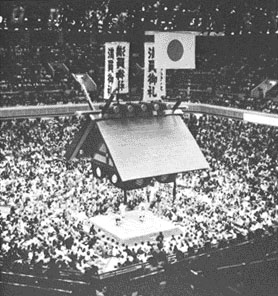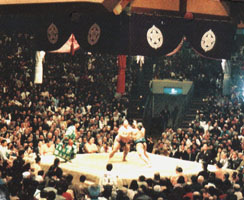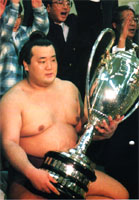Nihon Sumo Kyokai - The Japan Sumo Association, which is the governing body for sumo. It determines the rankings of the wrestlers, the order of bouts, the referees and judges, all rules and regulations, including punishment, such as expulsion of a wrestler.
Rikishi - a sumo wrestler registered with the Sumo Kyokai; literally a "gentleman of strength"
Makuuchi - the senior division for rikishi
Juryo - the junior division for rikishi
Sekitori - rikishi's in the makuuchi and juryo divisions
Makushita - the lower grade for sumo wrestlers, consisting of classes called Sandanme, Jonidan, and Jonokuchi
Heya - a stable to which a rikishi will belong for the whole of his career; usually set up by retired rikishi
Sumo is a world of its own in Japan, with its own history (of over 2,000 years), culture, rituals, rules and regulations, personalities, and system of values.
In its most basic form and at its lowest common denominator, sumo is a bout fought between two sumo wrestlers, one of whom emerges as the winner and the other the loser, of that bout. Wrestlers will be assigned bouts against other wrestlers in their own division without regard for the size, weight, or rank of either wrestler. However, wrestlers will not fight wrestlers from the same "heya" to which they belong as a living group, somewhat like being a member of a team.
The only time when a wrestler will fight against a wrestler from his own stable is when, on the last day of a championship series, two wrestlers from the same heya have an equivalent best record of wins and losses, and these two wrestlers must fight in a playoff bout to determine the winner.
There are about 800 sumo wrestlers in total, with about 40 in the makuuchi division.
To see a sumo bout, the first thing one notices about
the wrestlers is their immense size. As an example, Musashimaru,
who is actually from Hawaii but has become a Japanese citizen, stands 191
cm (6 ft 3.5 inches) tall, and weighs 196 kg (432 lbs.). Musashimaru
is the newest rikishi to attain the top rank of yokozuna, or grand champion.
They may look fat, but they are incredibly strong, agile, athletic, and
quick.
Ryogoku Kokugikan - the facility in Tokyo where the sumo basho is held
Kachi koshi - a rikishi's winning record for the tournament, of at least 8 wins or better, out of 15 bouts, usually meaning promotion in rank for the next tournament
Maki koshi - a losing record of 8 loses or more, usually meaning demotion in rank for the next tournament
Yusho - the tournament championship
Zensho yusho - a perfect record of 15 wins and no losses for a tournament
Six tournaments are held each calendar year, referred to as "basho" and delineated usually by the season of the basho, such as natsu, aki, or haru basho. Tournaments are held in different cities throughout Japan, with the three being in Tokyo, and others in Osaka, Nagoya, and Fukuoka.
Each tournament is 15 days long, with each rikishi fighting
once a day. The best winning record is 15 wins, 0 losses, then 14
-1, 13 -2, and so on. The order of bouts and opponents are determined
each day by the Sumo Kyokai, with the contenders for the tournament title
being paired against each other closer to the end of the tournament.
After the last bout on the 15th day, rikishi with the best identical winning
record will meet in a playoff bout to determine the tournament winner.
If no playoff is needed, then the rikishi with the best record is the tournament
winner.
 Overall
view of Kokugikan
Overall
view of Kokugikan
Ozeki - Champion
Sekiwake - Junior Champion
Komusubi - Middle Rank
Maegashira - Main Rank, and within this rank, there are sub-ranks of Maegashira 1, Maegashira 2, etc. up to Maegashira 15.
Juryo 1 - 15 - rikishi in this division are also ranked from juryo 1, juryo 2, etc., to juryo 15
Higashi - East, and Nishi - West. In a basho, rikishi are also divided into East and West sides, with the East side containing the rikishi of similar rank with the better recent records. These are arbitrary divisions, and have no particular meaning. Depending on who a rikishi is matched against on that day, he may enter the arena from the East or West side. The rikishi of the more senior rank will enter from his own East or West side, and the lower ranked rikishi from the other side.
Banzuke - the official ranking list of rikishi for the basho
A new rikishi will start in the juryo division, and fight in bouts against other wrestlers in the juryo division. With winning records, he will be promoted into the makuuchi division, and then be ranked according to the ranking shown on the left, with the top rank being yokozuna.
Rikishi receive monthly salaries from the Kyokai depending upon their ranks. Currently, yokozunas receive yen 2,300,000 per month (about US$19,000), and new rikishis in the juryo division receive a yen 720,000 (US$5,800) per month salary. Top ranked rikishi of course have many other sources of income, such as from sponsorship, advertising, and just outright gifts and donations. Companies may also offer a gift for an individual bout with the winner getting whatever amount is donated by the company. The winner of a basho will receive a money prize from the Kyokai of about yen 6 million (US$48,000).
For a rikishi to gain promotion to yokozuna rank, the Kyokai will have a deliberation after each tournament to assess any suitable candidate's record. While there are no fixed rules as to promotion to yokozuna, usually a rikishi will be promoted if he has excellent records in two successive tournaments, winning one of them and a record of 14 -1 or at least 13 -2 in the tournament he did not win. Luck also plays a part, depending on how many or few yokozunas are active at the moment. In any tournament recently, having two yokozunas was a blessing, and sometimes, there was only one yokozuna, with the other not competing due to injury. (I don't recall any tournament in which there were no yokozunas.)
In the late 1950's, there were four active yokozunas in
most tournaments, and that was a wealth of yokozunas. In the mid-1970's,
a tournament might have 2 or at most 3 yokozunas.
Two rikishi
Gyoji - the referee in the green outfit
Dohyo - the clay mound on which the bout is fought


A bout in progress at the Kokugikan, and on the right, Ozeki Takanonami holding the Emperor's Cup for capturing the Yusho for the New Year's Basho, 1996, with a 14 -1 record, and beating his stable mate, Yokozuna Takanohana, in a playoff bout (a kettei-sen) on the last day of the basho.